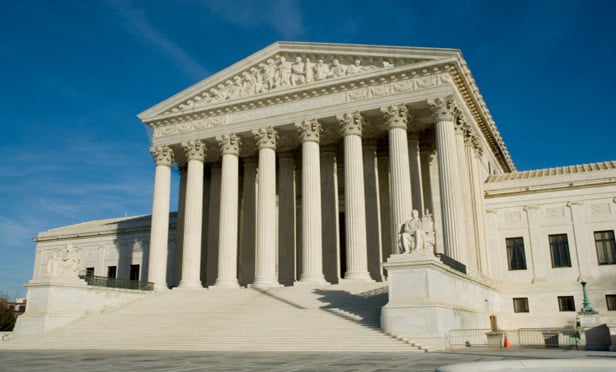Features

Understanding the Supreme Court Cases that Didn't Destroy the Internet: 'Gonzalez v. Google' and 'Twitter v. Taamneh'
The Internet is still standing, but the Supreme Court's reasoning in the Gonzalez opinion remains perplexing. Gonzalez and Taamneh are a story about how the Supreme Court "saved" the Internet from itself, and the Court needed both cases to do so.
Features

The Problem With Sup. Ct. Majority Opinion In Andy Warhol Foundation
Commentary The high court's decision's future application is anything but clear and clarification of the parameters of a "transformative" fair use is left open for another day.
Features

Supreme Court's Slack Ruling Could Curb 'Direct Listings' IPO Alternative
Messaging company Slack Technologies scored a unanimous victory in the U.S. Supreme Court last month, which held that an investor suing over a company stock offering must show he held "registered" securities in the company.
Features

The First Amendment and the Lanham Act At the Supreme Court
In March, the Supreme Court heard a blockbuster trademark case with significant implications for trademark law. After argument, reversal seems likely as questioning from the justices suggests that a long-standing precedent is unlikely to survive unscathed. But the Court also indicated concern over the broader implications of this case in the arts, entertainment, and publishing. Here's what you need to know about Jack Daniel's v. VIP Products.
Features

Acquitted-Conduct Sentencing: A Quagmire Neither the Supreme Court Nor the U.S. Sentencing Commission Can Continue to Avoid
It has been common knowledge to criminal practitioners for years that a criminal defendant's sentence for a crime which they have been convicted can be increased based on consideration of conduct that the jury acquitted. This outcome can make a partial acquittal in federal court into a pyrrhic victory.
Features

Rule 10b-5 Liability: The Second Circuit and 'Lorenzo'
Part Two of a Three-Part Article This three-part series discusses the Second Circuit's recent Securities law landmark case, S.E.C. v. Rio Tinto. However, in order to discuss Rio Tinto, it is important to first understand the Supreme Court landmark cases upon which Rio Tinto is based: Janus Capital Group, Inc. v. First Derivative Trader, discussed in the first installment, and S.E.C v. Lorenzo, discussed here.
Features

Innocent Business Partner's Fraud Liability Survives Bankruptcy
The decision by the Supreme Court has practical significance for corporate officers and others in an agency or partnership relationship, and also may have serious consequences for corporate Chapter 11 debtors whenever a "domestic governmental unit" is a creditor.
Features

Rule 10b-5 Liability: The Supreme Court and 'Janus'
Part One of a Three-Part Article This three-part series discusses the Second Circuit's recent Securities law landmark case, S.E.C. v. Rio Tinto. However, in order to discuss Rio Tinto, it is important to first understand the Supreme Court landmark cases upon which Rio Tinto is based: Janus Capital Group, Inc. v. First Derivative Trader and S.E.C v. Lorenzo. Janus is discussed here in the first installment.
Features

Circuit Split Reflects Disagreement About the Relationship Between Scheme Liability and SEC Rule 10b-5(b)
Historically, federal courts generally agreed that scheme liability under SEC Rule 10b-5(a) and (c) requires something more than a misstatement or omission — with misstatements and omissions typically being litigated under Rule 10b-5(b) instead. However, the SCOTUS in Lorenzo v. SEC held that an individual who disseminates a misstatement, without other fraudulent conduct, is potentially liable under the scheme liability provisions of Rule 10b-5. Subsequently, a circuit split has emerged over the scope of Lorenzo's holding.
Features

Report on Oral Arguments At Supreme Court In 'Warhol' Case
During the recent oral arguments before it, the U.S. Supreme Court sounded open to extending more fair use protection to an Andy Warhol painting of rock icon Prince than the U.S. Court of Appeals for the Second Circuit did.
Need Help?
- Prefer an IP authenticated environment? Request a transition or call 800-756-8993.
- Need other assistance? email Customer Service or call 1-877-256-2472.
MOST POPULAR STORIES
- How Secure Is the AI System Your Law Firm Is Using?What Law Firms Need to Know Before Trusting AI Systems with Confidential Information In a profession where confidentiality is paramount, failing to address AI security concerns could have disastrous consequences. It is vital that law firms and those in related industries ask the right questions about AI security to protect their clients and their reputation.Read More ›
- Pleading Importation: ITC Decisions Highlight Need for Adequate Evidentiary SupportThe International Trade Commission is empowered to block the importation into the United States of products that infringe U.S. intellectual property rights, In the past, the ITC generally instituted investigations without questioning the importation allegations in the complaint, however in several recent cases, the ITC declined to institute an investigation as to certain proposed respondents due to inadequate pleading of importation.Read More ›
- The Binding Effect of Plea Agreements In White Collar CrimesFederal plea agreements sometimes state explicitly that they are limited to that one office and do not bind other U.S. attorney's offices. In this article, we discuss the circuit courts' competing approaches to interpreting the binding effect of plea agreements and the Department of Justice policy.Read More ›
- Compliance and Third-Party Risk ManagementTo gauge the level of risk and uncover potential gaps, compliance and privacy leaders should collaborate to consider how often they are monitoring third parties, what intelligence they are gathering with and about their partners and vendors, and whether their risk management practices have been diminished due to cost and resource constraints.Read More ›
- Authentic Communications Today Increase Success for Value-Driven ClientsAs the relationship between in-house and outside counsel continues to evolve, lawyers must continue to foster a client-first mindset, offer business-focused solutions, and embrace technology that helps deliver work faster and more efficiently.Read More ›
